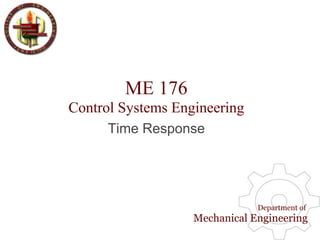
Lecture 6 ME 176 2 Time Response
- 1. ME 176 Control Systems Engineering Department of Mechanical Engineering Time Response
- 2. Introduction: Context Recent Topic : Modeling (in frequency domain) of open loop systems. Current Topic : Analysis of subsystems. Department of Mechanical Engineering
- 3. Introduction: Review Concepts: Two parts of system response: Transient Response Steady State Response Department of Mechanical Engineering Goal of control systems: Stability
- 4. Introduction: Review Subject: 1st & 2nd Order Systems Input: Step Function : 1/s Department of Mechanical Engineering Analysis: Transfer Function Extract Parameters Visual Representation - Graphs, Plots
- 5. Department of Mechanical Engineering Poles, Zeros, and System Response: Definition Poles Values of the Laplace Transform variable, s, that causes the transfer function to become infinite. Roots of the denominator of transfer function that are common to roots of the numerator. Zeros Values of the Laplace Transform variable, s, that causes the transfer function to become zero. Roots of the denominator of transfer function that are common to roots of the numerator. System Response Natural Response (Homogeneous Solution) - describes the way the system dissipates or acquires energy; dependent on the system. Forced Response (Particular Solution) - based on the input into the system.
- 6. Poles, Zeros, and System Response: Identify Parts Department of Mechanical Engineering
- 7. Poles, Zeros, and System Response: Concepts Department of Mechanical Engineering Forced Response Natural Response
- 8. Poles, Zeros, and System Response: Example Department of Mechanical Engineering Pole from input function generates the forces response . Pole from transfer function generates the natural response. Pole on real axis an exponential response of form: Negative alpa is pole location on real axis. Farther left pole is on negative real axis, the faster exponential transient response decay to zero. Zeros and poles generate amptitudes for both forced and natural responses.
- 9. First-Order Systems: Analysis Department of Mechanical Engineering
- 10. First-Order Systems: Graphic Analysis Department of Mechanical Engineering Tc : 1/a : Time constant. The time for exponential part of function to decay to 37% of its initial value. Tr : Rise time. The time for the waveform to go from 0.1 to 0.9 of its final value. Ts : Settling time. The time for the response to reach, and stay within 2% of its final value.
- 11. First-Order Systems: Exercise Department of Mechanical Engineering
- 12. Second-Order Systems: Analysis Use general equation of the following form: Use quadratic equation to get roots: Use step function as input. Exhibit wide variety of responses - system parameters not just change speed but form of responses. Types of 2nd order transient responses: Overdamped Underdamped Undamped Critically damped Department of Mechanical Engineering
- 13. Second-Order Systems: Overdamped Systems Poles : two real. Natural Response : two exponentials with time constants equal to the reciprocal of the pole locations: Department of Mechanical Engineering
- 14. Second-Order Systems: Underdamped Systems Poles : two complex. Natural Response : damped sinusoid with exponential envelope whose time constant is equal to the reciprocal of the pole's real part. The radian frequency of the sinusoid, the damped frequency oscillation, is equal to imaginary part of the poles: Department of Mechanical Engineering
- 15. Second-Order Systems: Undamped Systems Poles : two imaginary. Natural Response : undamped sinusoid with radian frequency equal to imaginary part of the poles: Department of Mechanical Engineering
- 16. Second-Order Systems: Critically damped Systems Poles : two real. Natural Response : one term is an exponential whose time constant is equal to the reciprocal of the pole location. Another term is the product of time, t, and the exponential with time constant equal to the reciprocal of the pole location: Department of Mechanical Engineering
- 17. Second-Order Systems: Example Use: Solve: Department of Mechanical Engineering
- 18. Second-Order Systems: Example Department of Mechanical Engineering
- 19. Second-Order Systems: Example Department of Mechanical Engineering
- 20. Second-Order Systems: Example Department of Mechanical Engineering
- 21. Second-Order Systems: Example Department of Mechanical Engineering
- 22. General Second-Order Systems: Definition Natural Frequency : is the frequency of oscillation of the system without damping. Damping Ratio : is the ration of the exponential decay frequency of the envelope to the natural frequency. Department of Mechanical Engineering
- 23. General Second-Order Systems: Definition Department of Mechanical Engineering
- 24. Second-Order Systems: Example Underdamped Department of Mechanical Engineering
- 25. Second-Order Systems: Example Overdamped Department of Mechanical Engineering
- 26. Second-Order Systems: Example Critically Damped Department of Mechanical Engineering
- 27. Second-Order Systems: Example Undamped Department of Mechanical Engineering
- 28. Quiz: For the transfer functions below, find the location of the poles and zeros, plot them on the s-plane, and then write an expressions for the general form of the step response without solving for the inverse Laplace transform. State the nature of each response: Department of Mechanical Engineering
